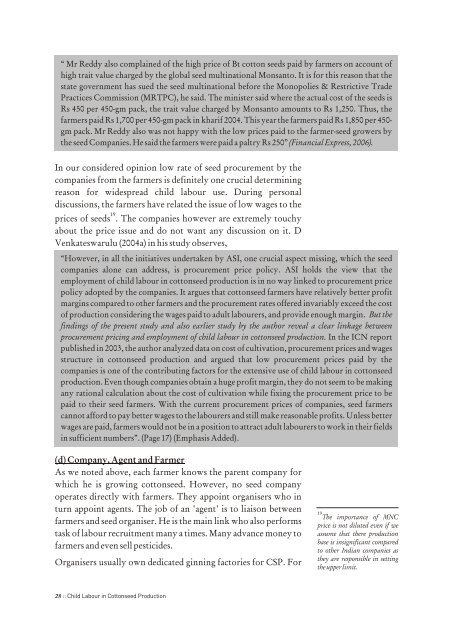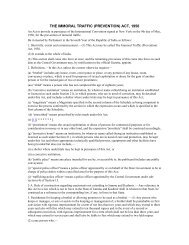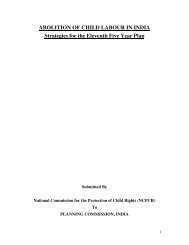Child Labour in Cottonseed Production by Ashok Khandelwal
Child Labour in Cottonseed Production by Ashok Khandelwal
Child Labour in Cottonseed Production by Ashok Khandelwal
Create successful ePaper yourself
Turn your PDF publications into a flip-book with our unique Google optimized e-Paper software.
“ Mr Reddy also compla<strong>in</strong>ed of the high price of Bt cotton seeds paid <strong>by</strong> farmers on account of<br />
high trait value charged <strong>by</strong> the global seed mult<strong>in</strong>ational Monsanto. It is for this reason that the<br />
state government has sued the seed mult<strong>in</strong>ational before the Monopolies & Restrictive Trade<br />
Practices Commission (MRTPC), he said. The m<strong>in</strong>ister said where the actual cost of the seeds is<br />
Rs 450 per 450-gm pack, the trait value charged <strong>by</strong> Monsanto amounts to Rs 1,250. Thus, the<br />
farmers paid Rs 1,700 per 450-gm pack <strong>in</strong> kharif 2004. This year the farmers paid Rs 1,850 per 450gm<br />
pack. Mr Reddy also was not happy with the low prices paid to the farmer-seed growers <strong>by</strong><br />
the seed Companies. He said the farmers were paid a paltry Rs 250” (F<strong>in</strong>ancial Express, 2006).<br />
In our considered op<strong>in</strong>ion low rate of seed procurement <strong>by</strong> the<br />
companies from the farmers is def<strong>in</strong>itely one crucial determ<strong>in</strong><strong>in</strong>g<br />
reason for widespread child labour use. Dur<strong>in</strong>g personal<br />
discussions, the farmers have related the issue of low wages to the<br />
19<br />
prices of seeds . The companies however are extremely touchy<br />
about the price issue and do not want any discussion on it. D<br />
Venkateswarulu (2004a) <strong>in</strong> his study observes,<br />
“However, <strong>in</strong> all the <strong>in</strong>itiatives undertaken <strong>by</strong> ASI, one crucial aspect miss<strong>in</strong>g, which the seed<br />
companies alone can address, is procurement price policy. ASI holds the view that the<br />
employment of child labour <strong>in</strong> cottonseed production is <strong>in</strong> no way l<strong>in</strong>ked to procurement price<br />
policy adopted <strong>by</strong> the companies. It argues that cottonseed farmers have relatively better profit<br />
marg<strong>in</strong>s compared to other farmers and the procurement rates offered <strong>in</strong>variably exceed the cost<br />
of production consider<strong>in</strong>g the wages paid to adult labourers, and provide enough marg<strong>in</strong>. But the<br />
f<strong>in</strong>d<strong>in</strong>gs of the present study and also earlier study <strong>by</strong> the author reveal a clear l<strong>in</strong>kage between<br />
procurement pric<strong>in</strong>g and employment of child labour <strong>in</strong> cottonseed production. In the ICN report<br />
published <strong>in</strong> 2003, the author analyzed data on cost of cultivation, procurement prices and wages<br />
structure <strong>in</strong> cottonseed production and argued that low procurement prices paid <strong>by</strong> the<br />
companies is one of the contribut<strong>in</strong>g factors for the extensive use of child labour <strong>in</strong> cottonseed<br />
production. Even though companies obta<strong>in</strong> a huge profit marg<strong>in</strong>, they do not seem to be mak<strong>in</strong>g<br />
any rational calculation about the cost of cultivation while fix<strong>in</strong>g the procurement price to be<br />
paid to their seed farmers. With the current procurement prices of companies, seed farmers<br />
cannot afford to pay better wages to the labourers and still make reasonable profits. Unless better<br />
wages are paid, farmers would not be <strong>in</strong> a position to attract adult labourers to work <strong>in</strong> their fields<br />
<strong>in</strong> sufficient numbers”. (Page 17) (Emphasis Added).<br />
(d) Company, Agent and Farmer<br />
As we noted above, each farmer knows the parent company for<br />
which he is grow<strong>in</strong>g cottonseed. However, no seed company<br />
operates directly with farmers. They appo<strong>in</strong>t organisers who <strong>in</strong><br />
turn appo<strong>in</strong>t agents. The job of an 'agent' is to liaison between<br />
farmers and seed organiser. He is the ma<strong>in</strong> l<strong>in</strong>k who also performs<br />
task of labour recruitment many a times. Many advance money to<br />
farmers and even sell pesticides.<br />
Organisers usually own dedicated g<strong>in</strong>n<strong>in</strong>g factories for CSP. For<br />
28 :: <strong>Child</strong> <strong>Labour</strong> <strong>in</strong> <strong>Cottonseed</strong> <strong>Production</strong><br />
19<br />
The importance of MNC<br />
price is not diluted even if we<br />
assume that there production<br />
base is <strong>in</strong>significant compared<br />
to other Indian companies as<br />
they are responsible <strong>in</strong> sett<strong>in</strong>g<br />
the upper limit.





